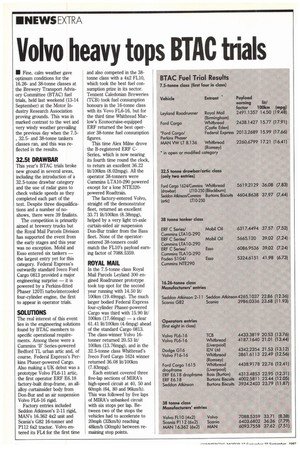Volvo heavy tops BTAC trials
Page 16

If you've noticed an error in this article please click here to report it so we can fix it.
• Fine, calm weather gave optimum conditions for the 16.26and 38-tonne classes at the Brewery Transport Advisory Committee (BTAC) fuel trials, held last weekend (13-14 September) at the Motor Industry Research Association proving grounds. This was in marked contrast to the wet and very windy weather prevailing the previous day when the 7.5, 32.5and 38-tonne tankers classes ran, and this was reflected in the results.
32.5t DRAWBAR
This year's BTAC trials broke new ground in several areas, including the introduction of a 32.5-tonne drawbar category and the use of radar guns to check vehicle speeds as they completed each part of the test. Despite three disqualifications and a number of noshows, there were 39 finalists.
The competition is primarily aimed at brewery trucks but the Royal Mail Parcels Division has supported the event from the early stages and this year was no exception. Mobil and Esso entered six tankers the largest entry yet for this category. Federal Express's outwardly standard Iveco Ford Cargo 0813 provided a major engineering surprise it is powered by a Perkins-fitted Phaser 120Ti turbo/intercooled four-cylinder engine, the first to appear in operator trials.
SOLUTIONS
The real interest of this event lies in the engineering solutions found by BTAC members to specific operational requirements. Among these were a Cummins 'B' Series-powered Bedford TL urban artic and, of course, Federal Express's Perkins Phaser-powered Cargo. Also making a UK debut was a prototype Volvo FL6-11 artic, the first operator ERF E6.18 factory-built drop-frame, an allalloy curtainsider body from Don-Bur and an air suspension Volvo FL6-16 rigid.
Factory entries included Seddon Atkinson's 2-11 rigid, MAN's 16.362 4x2 unit and Scania's G82 I6-tonner and P112 6x2 tractor. Volvo entered its FL4 for the first time and also competed in the 38tonne class with a 4x2 FL10, which took the best fuel consumption prize in its sector. Tennent Caledonian Breweries (TCB) took fuel consumption honours in the 16-tonne class with its Vovo FL6-16, but for the third time Whitbread Marlow's Econocruise-equipped ERF returned the best operator 38-tonne fuel consumption figures.
This time Alex Milne drove the B-registered ERF CSeries, which is now nearing its fourth time round the clock, to return an excellent 36.22 lit/1001cm (8.02mpg). All the operator 38-tonners were Cummins LTA10-290 powered except for a lone NTE320powered Roadtrain.
The factory-entered Volvo, straight off the demonstrator fleet, returned an excellent 33.71 lit/100km (8.38mpg), helped by a very light tri-axle curtain-sided air suspension Don-Bur trailer from the Bass fleet. None of the operatorentered 38-tonners could match the FLIO's payload earning factor of 7088.5359.
ROYAL MAIL
In the 7.5-tonne class Royal Mail Parcels Leyland 300 engined Roadrunner prototype took top spot for the second year running with 14.50 lit/ 1001cm (19.49mpg). The much larger bodied Federal Express four-cylinder Phaser-powered Cargo was third with 15.90 lit/ 1001cm (17.66mpg) a clear 61.41 lit/100km (4.6mpg) ahead of the standard Cargo 0813. The class-winner Volvo 16tomer returned 20.53 lit/ 1001cm (13.76mpg), and in the 32.5-tonne class Whitbread's Iveco Ford Cargo 1624 winner returned 36.08 lit/100km (7.83mpg).
Each entrant covered three five-lap sections of MIRA's high-speed circuit at 40, 50 and 60mph (64, 80 and 96km/h). This was followed by five laps of MIRA's unbanked circuit with six stops per lap. Between two of the stops the vehicles had to accelerate to 20mph (321cm/h) reaching 481crn/h (30mph) between remaining stop points.




































































































